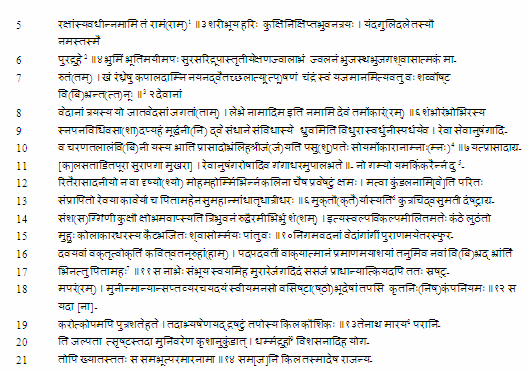| |
North
Indian Inscriptions |
| |
|
|
|
INSCRIPTIONS OF THE PARAMARAS OF MALWA

Second Plate: Second Side

______________________________________________________
[1] Here the number marking the verse is omitted. This verse shows a contradiction, stating that the king
who was devoted to Vishṇu made the demons happy. The figure is Virōdhābhāsa, and the contradict-
tion which is only apparent, disappears by taking the word dānāvān in nominative singular and as an
adjective to the name of the king.
[2] The splitting up of the name itself into two parts, the first of which ends in the third foot and the second
begins in the fourth, is erroneous, making the pause fall in the middle of the name.
[3] The sign of anusvāra was first engraved on each of the three lingual nasal and then scored off as un necessary.
[4] Dr. Sircar who prepared his text from an unsatisfactory impression, observed : “three syllables are
omitted here due to the carelessness of the scribe or engraver.” But these three syllables, which were
originally omitted by the writer, were subsequently written by him and are engraved in smaller size
above the line and they are also preceded by an arrow-head, pointing out where they are actually
to be supplied. They are put in brackets here. Thus it is neither the fault of the writer nor of the
engraver.
[5] This foot of the verse offends against the metre, and the defect would disappear, as observed by Sircar,
by reading प्यसौ in place of स्य.
[6] This letter is preceded by a redundant त, which was erased later on. The sign is clear on the plate.
[7] These two akshara were repeated inadvertently.
[8] By the use of double entendre the expressions in this verse are applicable to both ¬¬–– Sindhurāja and
the sea.
[9] The word dantāvala in the first half of this verse is wrongly broken into two. The last syllable of
the verse has an anusvāra also and the sign of visarga appears to have been scratched off subscquently.
The word prachura which was first used in neuter has also been left unaltered. The correct reading
would be उद्भविष्णु . . . . . प्रचुरोपि . . . . . . पंकः।
[10] Compare राधां विधत्ते स्म यः in the second verse of the Pārijātamañjarī. By changing the consonant of
the second letter the name becomes Rāḍhā and the expression be taken to mean that Bhōja rendered
(the country of) Rāḍhā (Rāḍha) bereft of her lord, but this account is not supported by any other
evidence. According to some, the word means Rādhā-yantra, i.e., the observatory. Here compare the
verse of the P. C. M. : भोजराज, मया ज्ञातं राधावेधस्य कारणम् । धाराया विपरीतं हि सहते न भवानिति ॥
[11] This verse reminds us of Raghuvaṁśa, IV, vv. 29 and 31.
|
\D7
![]()
|









